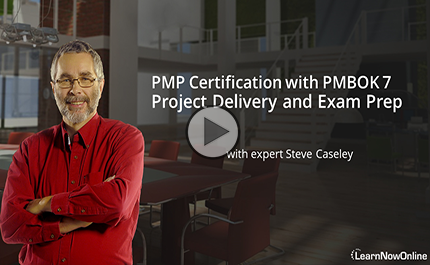Course description
The new version of the Project Management Professional (PMP)® certification exam launched on 2 January 2021. It took existing version 6 content and reoriented the focus while adding Agile Content. This course covers Tools and Techniques. Over 100 tools and techniques exist, and the most important and complex of these are explained here.
Prerequisites
It will be helpful to have watched earlier parts in the PMP Certification (PMBOK 6) series
Meet the expert
Steve has been involved in the Information Technology Industry for over 35 years and is experienced in the management and control of all aspects of technology projects. Steve has successfully delivered a myriad projects in a large number of industry segments. He has developed a solid understanding of the issues and principles required to successfully implement solutions using a combination of rapid development techniques and traditional Project Management to ensure projects are delivered on time while still ensuring end user satisfaction. Steve has lectured part-time at local universities teaching courses in Project Management, Information Systems and Systems Analysis at both graduate and under-graduate levels.
Course outline
Tools and Techniques
Tools and Techniques (05:20)
- Introduction (00:59)
- Tools and Techniques (02:40)
- Ungrouped Tools (01:29)
- Summary (00:11)
Data Gathering Tools and Techniques (18:30)
- Introduction (00:24)
- Data Gathering Tools and Techniques (09:15)
- Focus Groups (07:04)
- Statistical Sampling (01:41)
- Summary (00:04)
Data Analysis (22:02)
- Introduction (00:24)
- Data Analysis (06:19)
- Performance Reviews (02:49)
- Reserve Analysis (12:23)
- Summary (00:04)
Data Representation (10:42)
- Introduction (00:25)
- Data Representation (03:53)
- Control Chart (02:49)
- Stakeholder Engagement Matrix (03:27)
- Summary (00:05)
Decision Making (04:24)
- Introduction (00:21)
- Decision Making (02:23)
- Voting (01:34)
- Summary (00:04)
Communications Skills (05:54)
- Introduction (00:21)
- Communications Skills (02:37)
- Presentations (02:50)
- Summary (00:04)
Interpersonal Team Skills (10:25)
- Introduction (00:27)
- Interpersonal Team Skills (04:16)
- Conflict Management (05:34)
- Summary (00:07)
Cost of Quality (07:10)
- Introduction (00:33)
- Cost of Quality (03:40)
- Cost of Conformance Examploes (02:47)
- Summary (00:09)
More Tools and Techniques
Decision Tree Analysis (06:20)
- Introduction (00:22)
- Decision Tree Analysis (01:11)
- Example (04:32)
- Summary (00:13)
Earned Value Analysis (33:16)
- Introduction (01:10)
- Earned Value Analysis (05:28)
- Status (06:14)
- Earned Value Snapshot (05:33)
- Earned Value Formulas (07:55)
- Interpretations (05:51)
- Summary (01:02)
Meetings (09:52)
- Introduction (00:50)
- Meetings (02:01)
- Effective Meetings (06:49)
- Summary (00:10)
Precedence Diagramming (15:46)
- Introduction (00:45)
- Precedence Diagramming (08:41)
- Dependency Classification (06:03)
- Summary (00:16)
Critical Path Method (14:56)
- Introduction (00:59)
- Critical Path Method (06:23)
- Draw Networrk Diagram (07:08)
- Summary (00:25)
Risk Probability (15:25)
- Introduction (01:00)
- Risk Probability (03:43)
- Demo: Risk Probability (10:27)
- Summary (00:14)
Root Cause Analysis (05:50)
- Introduction (00:19)
- Root Cause Analysis (02:16)
- Five Whys (03:04)
- Summary (00:10)
Rolling Wave Planning (09:36)
- Introduction (01:38)
- Rolling Wave Planning (03:03)
- Rolling Wave Planning Example (04:40)
- Summary (00:14)



